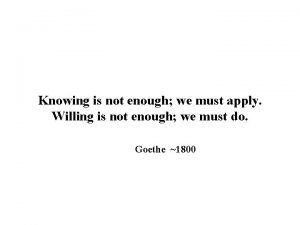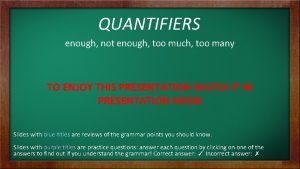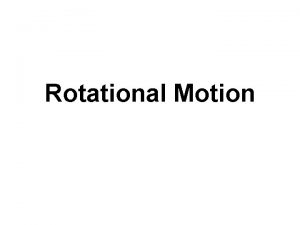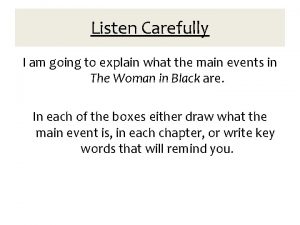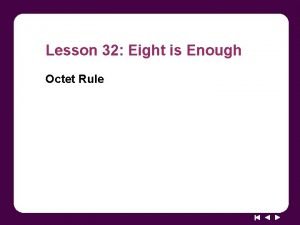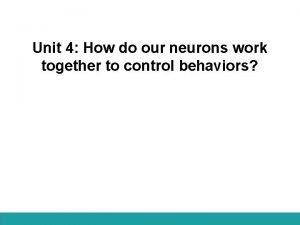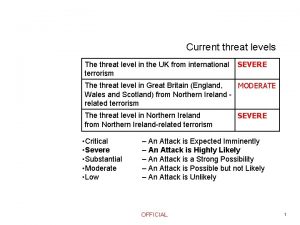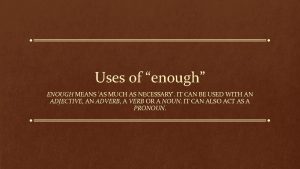When Words Are Not Enough Precursors to Threat






























- Slides: 30

When Words Are Not Enough Precursors to Threat: An Early Warning System for School Counsellors 2005

Why have an early warning system? l l Prevent declines in social/emotional/behavioural baseline Delay impending behaviours that may be threatening to self, others, or property De-escalate impending behaviours that may be threatening to self, others, or property Improve school climate through responsive counselling services

Why use baseline indicators? l l l Recognize subtle cues to individual change Focus on student-specific attributes Consider a research-based range of elements Reduce assumptions Collect objective data Alert threat assessment teams and/or referral agencies using common language

Why have a threat assessment team? l l l Rapid Response Capabilities Clear role expectations Clear communication Clear link to critical incident response team Increased communication Team approach allows specific skill sets to be used to advantage

Who should be included on an initial response threat assessment team? l l l Principals School counsellors¹ School psychologists¹ Teachers (especially with specialized training such as WEVAS) Local police/RCMP Community liaisons² (such as local police, community mental health worker, physician, social worker…) ¹Dependent upon availability within the school division ²Dependent upon need for a multi-disciplinary approach based on comprehensive nature of risk.

How should we prepare if we have no threat assessment team? l Create a plan that all staff know and can use l Dial 911/emergency services for immediate risk situations l Use counselling services and related networks for multi-disciplinary responses as needed

How should we prepare if we have no threat assessment team? l Use the critical incident preparedness plan for threat-making and immediate risk situations l Use existing protocols for discipline, emergency medical situations and counselling referrals for worrisome behaviour l Train teachers to notice imminent threats and report them to the Principal for action

Focus on the Student: A Risk Continuum Baseline Unsettling Worrisome High-Profile Threat- Immediate Behaviour Worrisome Making Risk Behaviour Situations School Counsellor Threat Assessment Team (including consultation and referrals as required) (including school counsellor)

Dynamics of Behaviour -1 l FAMILY DYNAMICS – – – Turbulent parent-child relationship Acceptance of pathological behaviour Access to weapons Lack of intimacy Student “rules the roost” No limits or monitoring of TV/Internet

Dynamics of Behaviour -2 l SCHOOL DYNAMICS – – – Detached from school Tolerance for disrespect Inequitable discipline Inflexible culture Student pecking order Code of silence

Dynamics of Behaviour -3 l SCHOOL DYNAMICS – – – Unsupervised computer access Unmonitored access to violent media, entertainment, technology Violent/extremist peer group Drug and alcohol use Violent/extreme outside interests Copycat effect

Balancing Risk and Resiliency l CONSIDER SCHOOL RESILIENCY FACTORS – – – Nurturing staff and positive role models Creative, supportive leadership Orderly, flexible climate Support and mentoring from staff High expectations, frequent monitoring of student progress Avoidance of negative labeling and tracking

Balancing Risk and Resiliency l CONSIDER SCHOOL RESILIENCY FACTORS cont’d – – – Opportunities for participation Individualized instruction Culturally diverse curriculum Variety of experience to discover talents Meaningful student activities and contributions Parent and community participation

Balancing Risk and Resiliency l CONSIDER COMMUNITY RESILIENCY FACTORS cont’d – – – – Caring and support of families and schools Promotion and support of social networks Provision of resources for healthy development High expectations and clear norms for families and schools Assurance that youth are valued resources Opportunities for active participation and collaboration Creation of meaningful opportunities for youth to contribute to community and serve others

Balancing Risk and Resiliency l CONSIDER FAMILY RESILIENCY FACTORS – – – – Caring and support of student Family encouragement of student in school and school activities Monitoring time student spends with peers, watching TV, at home, at school, in related activities Supportive and affectionate relationships High-warmth, low-criticism parenting Attention to nutrition High expectations for academic and social performance

Balancing Risk and Resiliency l CONSIDER FAMILY RESILIENCY FACTORS cont’d – – Daily routines that include structure, discipline and clear rules Opportunities for participation in a variety of experiences to discover and develop talents Participation with and contribution to family in meaningful ways Domestic chores to develop responsibility

Baseline Behaviour - 1 CLINICAL DIAGNOSES such as: Conduct disorder Oppositional Defiant Disorder ADD/ADHD Mood Disorders Personality Disorders FAS/FAE Psychopathology Child abuse/neglect Other

Baseline Behaviour - 2 UNDIAGNOSED FACTORS UNREPORTED FACTORS PERSONALITY TRAITS: Frustration/tolerance levels Coping skills Resiliency levels Connection/alienation Empathy levels

Baseline Behaviour - 3 Cont’d PERSONALITY TRAITS: Superiority/inferiority levels Self-esteem Trust levels Humour/perspective Rigidity Violence levels/defiant behaviour Bullying/bullied

Unsettling Behaviour - 1 Change in: Baseline behaviour Diagnostic symptoms Social group Life event Academic function Attendance Behaviour Violence levels Family Tolerance/Stress Attachment

Unsettling Behaviour - 2 Trauma/Tragedy Humiliation/Shaming event Loss of Support Home and School: Concerned: Peer(s) Teacher(s) Parent(s)

Unsettling Behaviour - 3 Increased: Impulsivity Self-deprecation Risk-taking Secrecy Self-harm Absenteeism/Withdrawal Attention-seeking behaviour Preoccupation Bullying

Worrisome Behaviour - 1 Change in baseline behaviour Change in diagnostic symptoms Unable to forget/forgive past perceived or real injustices Behaviour appears relevant to carrying out a threat Leakage (clues to impending violence) Subtle threats Subtle boasting Fantasies Attitudes/ultimatums Thoughts/feelings Low tolerance for frustration

Worrisome Behaviour - 2 Poor coping skills Lack of resiliency Failed love relationship Unusual interested in sensational violence Fascination with violence-filled entertainment Signs of depression Narcissism Alienation Dehumanizes others Lack of empathy

Worrisome Behaviour - 3 Exaggerated sense of entitlement Attitude of superiority Exaggerated/pathological need for attention Externalizes blame Masks low self-esteem Anger management problems Intolerance Inappropriate humour Seeks to manipulate others

Worrisome Behaviour - 4 Lack of trust Closed social group Change in behaviour Rigid/opinionated Negative role models

High-Profile Worrisome Behaviour Change in baseline behaviour Change in diagnostic symptoms Risk to self Dangerous impulsivity Possible risk to others Subtle or generalized threats without a specific timeline, plan, or opportunity Elevated sensitivity to others to threat due to recent or local violence incident(s) Probability of trauma for others based on over-reaction, echo-effect

Threat-Making Behaviour Change in baseline behaviour Change in diagnostic symptoms Risk to self Dangerous impulsivity Risk to others Threat with a plan – no specific timeline, possible opportunity Verbal or written threat to kill self and/or others Internet website/MSN threats to kill others Possession of weapons (including replicas) Bomb threat Fire-setting

Immediate Risk Behaviour Change in baseline behaviour Change in diagnostic symptoms Risk to self Dangerous impulsivity Risk to others Threat with a specific plan, timeline, and opportunity Armed inside the building Armed outside the building

For further information: Lorna Martin Manitoba Education, Citizenship and Youth Phone: 204 945 -7964 Fax: 204 945 -8843 lormartin@gov. mb. ca
 Mikael ferm
Mikael ferm Too enough not enough
Too enough not enough Our failing schools enough is enough
Our failing schools enough is enough Im good enough i'm smart enough
Im good enough i'm smart enough Our failing schools enough is enough summary
Our failing schools enough is enough summary Non-carbohydrate precursors
Non-carbohydrate precursors Rbc erythropoiesis
Rbc erythropoiesis Security is always too much until the day it is not enough
Security is always too much until the day it is not enough Learning is not enough we must apply
Learning is not enough we must apply Not enough nelsons.com
Not enough nelsons.com Not enough grammar
Not enough grammar Complete the sentences using these words
Complete the sentences using these words English 9 vocabulary unit 1
English 9 vocabulary unit 1 Thinking that only westerners are skilled enough
Thinking that only westerners are skilled enough Too enough quiz
Too enough quiz Too enough kahoot
Too enough kahoot Goodenough harris drawing
Goodenough harris drawing You have been at this mountain long enough
You have been at this mountain long enough Had enough power to do its job
Had enough power to do its job So such too enough
So such too enough Difference between force and torque
Difference between force and torque Listen carefully i am going to give you
Listen carefully i am going to give you Lesson 32 eight is enough octet rule
Lesson 32 eight is enough octet rule What is this
What is this In his poem thanatopsis dgp
In his poem thanatopsis dgp The cross before me the world behind me
The cross before me the world behind me Safe enough summary
Safe enough summary If you don't sleep enough
If you don't sleep enough Claire bought just enough fencing
Claire bought just enough fencing The best bridge between despair and hope
The best bridge between despair and hope Why exercise enough weight
Why exercise enough weight








